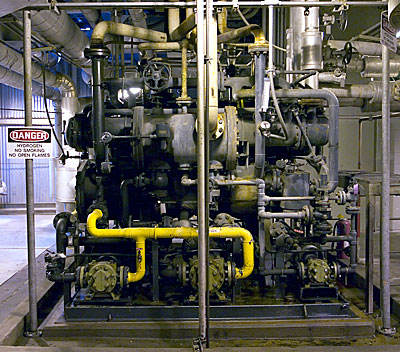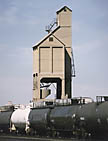- email: brian@bit-player.org
Listed below are some corrections pointed out by readers, and a few updates.
Generator Sealing Oil
(Correction, June 23, 2009)

The photograph above appears on page 197 of Infrastructure. The accompanying caption says that this machinery circulates gaseous hydrogen through the windings of the generator in an electric power plant. David Slater, a reader of the book who has much hands-on experience with such equipment, points out that the book's description is incorrect. The pumps and valves and other devices on view here regulate the supply of pressurized oil to sealing rings that help keep the hydrogen from leaking out of the generator. At each end of the generator, where the rotating shaft passes through the housing, a film of oil between closely fitted brass rings prevents the hydrogen from escaping. Some hydrogen is absorbed by the oil. The presence of this hydrogen explains the warning sign visible at left.
Methyl Mercaptan
(Correction, April 15, 2009)
Jon Williams points out an error on page 180, in the petroleum chapter. I refer to methyl mercaptan, the stinky stuff added to natural gas, as a mercury compound. This is incorrect—fortunately so, Williams notes, since mercury is a toxic metal that we probably don't want to be pumping through all the world's gas mains. In fact methyl mercaptan is a compound of sulfur rather than mercury. Also known as methanethiol, it has the formula CH3SH.
Not to make excuses for my mistake, but there is a connection between mercaptan and mercury. It turns out that molecules with an –SH group have a strong affinity for mercury and certain other metals. The name mercaptan comes from the Latin phrase mercurium captans, which translates roughly as seizing mercury.
Power Lines and Toasters
(Correction, December 31, 2007)
John Urbanic has pointed out a serious error in the chapter on electric power. On page 233, in a discussion of why long-distance power lines operate at very high voltages, I wrote:
To push more electricity through a power line, you can either increase the current or increase the voltage. But higher currents heat the conductors, just as they heat the filament in a light bulb or a toaster. For any given conductor, there is a maximum safe current. Once you reach that point, the only way to transmit more power is to keep the current constant and go to higher voltages. At the same current, a 345-kilovolt feeder carries more than 6 times as much power as a 138-kilovolt line, and a 765-kilovolt transmission line carries 30 times as much.
The numbers in the last sentence of this passage are incorrect. They were calculated on the (false) premise that when current is held constant, power capacity increases as the square of the voltage. In fact power is simply the product of current and voltage. Thus the 345-kilovolt feeder has about two and a half times the power capacity of a 138-kilovolt line; going to 765 kilovolts provides five and a half times the capacity, again compared to 138 kilovolts.
This mistake came about through muddled thinking on my part. The benefit of operating a transmission line at a higher voltage does indeed increase as the square of the voltage, but not in the way I stated. I should have written something like the following:
To push more electricity through a power line, you can either increase the current or increase the voltage. But higher currents heat the conductors, just as they heat the filament in a light bulb or a toaster. The power wasted by this “resistive” heating of the conductors grows as the square of the current, and so the waste is reduced by raising the voltage and lowering the current. If a transmission line’s voltage is doubled while its current is cut in half, the power capacity of the line remains constant, but the losses caused by resistive heating fall to one-fourth of their former value.
For those interested in the mathematics behind this statement, it goes like this. The two equations that govern the behavior of the transmission line are P = VI and V = IR, where P is power, V is voltage, I is current, and R is resistance. The second equation (which is a version of Ohm’s Law) implies that one can substitute IR for V in the first equation, yielding P = I2R. If R is the reistance of the transmission-line conductors, then I2R is the power lost to resistive heating.
A Coaling Tower, Not a Grain Elevator
(Correction, August 27, 2007)
 In Chapter 9, on railroads, a photo caption on page 353 identifies a tall concrete structure as “a lonely looking grain elevator.” The structure is actually a coaling tower, used to refill the coal tender cars of locomotives in the age of steam. The error was reported by an anonymous reader on March 30, 2006, and then again by Eric H. Johnson on August 20, 2007.
In Chapter 9, on railroads, a photo caption on page 353 identifies a tall concrete structure as “a lonely looking grain elevator.” The structure is actually a coaling tower, used to refill the coal tender cars of locomotives in the age of steam. The error was reported by an anonymous reader on March 30, 2006, and then again by Eric H. Johnson on August 20, 2007.
Heavy Jets and Thrust Reversers
(Correction, August 27, 2007)
Matthew Dixon Cowles points out two mistakes in Chapter 11, “Aviation.” Page 431 refers to the Boeing 747 and the Airbus A320 as “heavy” jets, which is a correct description for the 747 but not for the A320. The International Civil Aviation Organization defines a “heavy” aircraft as one with a maximum takeoff weight of at least 300,000 pounds. Some versions of the 747 can reach more than double this weight, but the A320 is limited to about 170,000 pounds. A later Airbus model, the A330, is indeed “heavy,” with a maximum takeoff weight of more than 500,000 pounds. (And a new Airbus, the A380, which entered commercial service in 2007, is “heavy” by anyone's standard, with a maximum takeoff weight of 1.2 million pounds!)
Cowles also corrects another of my misstatements:
On page 429 you mention that a jet's thrust reversers can't be used to back out of a parking place. In fact, sometimes they can be used that way, but they very rarely are. The reason that it's rare, of course, is that in a confined space running most planes' engines with reversers deployed would stir up a lot of dirt and grit, much of which would be sucked into their intakes. Foreign-object damage (called FOD) would quickly be the result. But some aircraft, such as DC-9s, have their engines mounted sufficiently high and sufficiently far back that FOD isn't a big risk. Some airlines routinely have some of their aircraft at some of their gates back away from the gate using reversers. That's called a "powerback" in contrast to a pushback, which a plane gets from a tug.
I should add that Cowles has posted a thoughtful review of Infrastructure on his Mondo's Info blog.
Botts Dots and Cat's Eyes
(Update, February 13, 2006)
On page 348 I describe Botts Dots—plastic reflectors that are glued to roadways to serve as lane markers on many American highways. The devices are named for Elbert Dysart Botts, an engineer with the California Department of Transportation, who supervised a study of their design in the late 1950s.
Paul Townend writes me to point out that a device with exactly the same function is known in Britain as a Cat's Eye. Furthermore, the British invention predates the American one by at least two decades. The Cat's Eye was devised by a Yorkshire road worker, Percy Shaw, and patented in 1934. As the story goes, Shaw was driving home on a foggy night and was saved from an accident by the reflected flash of his headlights in the eyes of a cat at the roadside. From this inspiration he designed glass reflectors in a metal-and-rubber housing that could be embedded in the road surface. The reflector cleans itself each time a car tire passes over it.
Even within the U.S. there are competing claims over the provenance of road-surface reflectors. The style of reflector seen on most American roadways—a rectangular plastic lump with two beveled surfaces—was patented by Sidney A. Heenan in 1964.
Two Wikipedia articles, "Raised pavement marker" and "Cat's eye (road)", give more background.
The Last Telegram
(Correction, February 13, 2006)
In the Communications chapter, a box on page 282 states: “As for Western Union, the name survives, but the last telegraph operations in the United States were shut down in 1989.” Apparently my report of the telegraph's demise was premature. According to widespread news reports, the last Western Union telegrams were sent on January 26, 2006. The Western Union web site announces the end of 150 years of telegraphy with a curt notice: “Effective January 27, 2006, Western Union will discontinue all Telegram and Commercial Messaging services. We regret any inconvenience this may cause you, and we thank you for your loyal patronage.”
Neutron Absorbers
(Correction, January 26, 2006)
John McCarthy, Professor Emeritus of Computer Science at Stanford University, sends the following note:
Obligatory niggle: You say on page 203 that carbon and boron are neutron absorbers. Boron is, but carbon absorbs so few that carbon was used as a moderator for Enrico Fermi's very first reactor in 1942 that used unenriched uranium. It was also the moderator, I think, for the Hanford plutonium production reactors, and for the Soviet RBMK reactors.
Professor McCarthy is entirely correct. Carbon has very low neutron absorption and is used to slow neutrons, not to remove them from the reaction.
Biofuels
(Update, January 26, 2006)
The discussion of biofuels on pages 127 and 128 asks whether growing corn and converting it into ethanol for use as a motor fuel might not actually use more petroleum than it saves. This question is addressed in a recent article in Science by Alexander E. Farrell of the University of California at Berkeley and five co-authors. Re-examining six earlier studies, they criticize two of them for "incorrectly assuming that ethanol coproducts (materials inevitably generated when ethanol is made, such as dried distiller grains with solubles, corn gluten feed, and corn oil) should not be credited with any of the input energy and by including some input data that are old and unrepresentative of current processes, or so poorly documented that their quality cannot be evaluated." Upon correcting for these factors, Farrell and his colleagues conclude that "corn ethanol reduces petroleum use by about 95% on an energetic basis." But this will surely not be the last word on the controversy.
Reference: Farrell, Alexander E., Richard J. Plevin, Brian T. Turner, Andrew D. Jones, Michael O'Hare, Daniel M. Kammen. "Ethanol Can Contribute to Energy and Environmental Goals." Science, January 27, 2006, vol. 311, pp. 506-508.